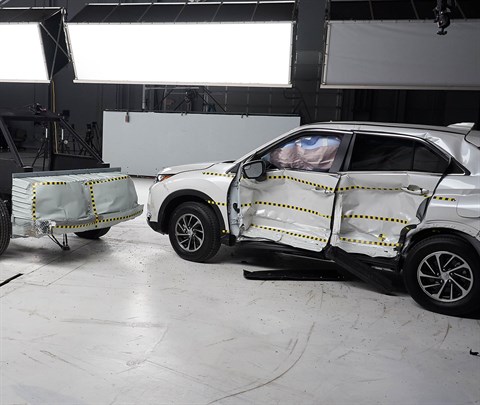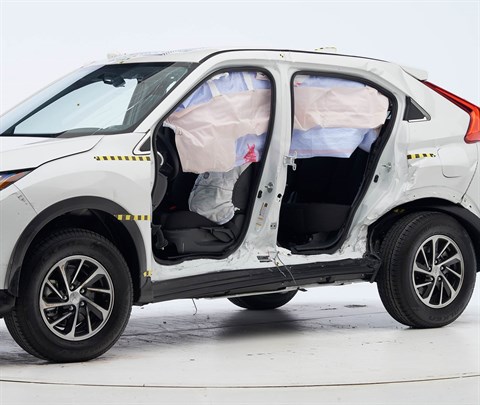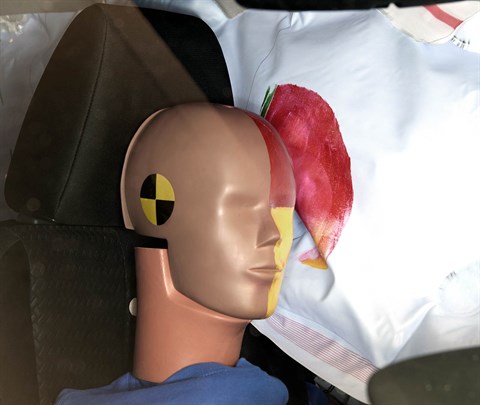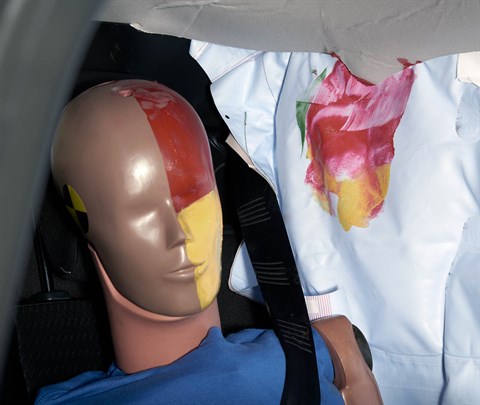Small overlap front: driver-side
Rating applies to 2018-25 models
Tested vehicle: 2019 Mitsubishi Eclipse Cross SEL 4-door 4wd
The Mitsubishi Eclipse Cross was introduced in the 2018 model year and is derived from the Mitsubishi Outlander. There was no 2021 model year produced. Driver-side small overlap frontal ratings are assigned by the Institute based on a test conducted by Mitsubishi.
| Evaluation criteria | Rating |
|---|---|
| Structure and safety cage | |
| Driver injury measures | |
| Head/neck | |
| Chest | |
| Hip/thigh | |
| Lower leg/foot | |
| Driver restraints and dummy kinematics | |
Small overlap front: passenger-side
Rating applies to 2018-25 models
Tested vehicle: 2018 Mitsubishi Eclipse Cross ES 4-door 4wd
The Mitsubishi Eclipse Cross was introduced in the 2018 model year and is derived from the Mitsubishi Outlander. There was no 2021 model year produced. Passenger-side overlap frontal ratings are assigned by the Institute based on a test conducted by Mitsubishi.
| Evaluation criteria | Rating |
|---|---|
| Overall evaluation | |
| Structure and safety cage | |
| Passenger injury measures | |
| Head/neck | |
| Chest | |
| Hip/thigh | |
| Lower leg/foot | |
|
Passenger restraints and dummy kinematics
The dummy’s head contacted the frontal airbag but slid off toward the right side, leaving the head vulnerable to contact with forward structure. The side curtain airbag deployed and has sufficient forward coverage to protect the head from contact with side structure and outside objects. The side torso airbag also deployed. | |
| Driver injury measures | |
| Head/neck | |
| Chest | |
| Hip/thigh | |
| Lower leg/foot | |
| Driver restraints and dummy kinematics | |
Moderate overlap front: original test
Rating applies to 2018-25 models
Tested vehicle: 2018 Mitsubishi Eclipse Cross SE 4-door 4wd
The Mitsubishi Eclipse Cross was introduced in the 2018 model year and is derived from the Mitsubishi Outlander. There was no 2021 model year produced. Moderate overlap frontal ratings are assigned by the Institute based on a test conducted by Mitsubishi.
| Evaluation criteria | Rating |
|---|---|
| Overall evaluation | |
| Structure and safety cage | |
| Driver injury measures | |
| Head/neck | |
| Chest | |
| Leg/foot, left | |
| Leg/foot, right | |
| Driver restraints and dummy kinematics | |
Side: original test
Rating applies to 2018-24 models
Tested vehicle: 2018 Mitsubishi Eclipse Cross SE 4-door 4wd
The Mitsubishi Eclipse Cross was introduced in the 2018 model year and is derived from the Mitsubishi Outlander. There was no 2021 model year produced. Side ratings are assigned by the Institute based on a test conducted by Mitsubishi.
| Evaluation criteria | Rating |
|---|---|
| Overall evaluation | |
| Structure and safety cage | |
| Driver injury measures | |
| Head/neck | |
| Torso | |
| Pelvis/leg | |
| Driver head protection | |
| Rear passenger injury measures | |
| Head/neck | |
| Torso | |
| Pelvis/leg | |
| Rear passenger head protection | |
Side: updated test
Rating applies to 2018-25 models
Tested vehicle: 2020 Mitsubishi Eclipse Cross 4-door 4wd
The Mitsubishi Eclipse Cross was introduced in the 2018 model year and is derived from the Mitsubishi Outlander. There was no 2021 model year produced.
| Evaluation criteria | Rating |
|---|---|
| Overall evaluation | |
| Structure and safety cage | |
| Driver injury measures | |
| Head/neck | |
| Torso | |
| Pelvis | |
| Driver head protection | |
| Rear passenger injury measures | |
| Head/neck | |
| Torso | |
| Pelvis | |
| Rear passenger head protection | |

View of the vehicle just after the crash test.

View of the vehicle after the crash with doors removed, showing the side airbags and damage to the occupant compartment.

Smeared greasepaint shows where the driver dummy's head was protected from being hit by hard structures by the side airbags.

Smeared greasepaint shows where the rear passenger dummy’s head was protected by the side airbag.
Roof strength
Rating applies to 2018-23 models
Tested vehicle: 2019 Mitsubishi Eclipse Cross ES 1.5T 4-door 4wd
| Overall evaluation | |
|---|---|
| Curb weight | 3,401 lbs |
| Peak force | 16,709 lbs |
| Strength-to-weight ratio | 4.91 |
Head restraints & seats
Seat type: Manual cloth seat
| Overall evaluation | |
|---|---|
| Dynamic rating | |
| Seat/head restraint geometry |
About the head restraint & seat test
Currently, IIHS tests apply only to front seats.
Headlights
Ratings are given for 3 different headlight variations available on this vehicle.
Trim level(s)
- SEL trim equipped with Touring package
| Evaluation criteria | Rating |
|---|---|
| Low-beam headlight type | LED projector |
| High-beam headlight type | LED projector |
| Curve-adaptive? | No |
| High-beam assist? | Yes |
|
Overall rating | |
| Distance at which headlights provide at least 5 lux illumination: | |
Low beams
On the straightaway, visibility was good on the right side of the road and fair on the left side. On curves, visibility was good on both right curves, fair on the sharp left curve and inadequate on the gradual left curve.
The low beams created some glare.
High beams
On the straightaway, visibility was good on the right side of the road and fair on the left side. On curves, visibility was inadequate in all 4 tests.
High-beam assist compensates for some limitations of this vehicle's low beams on the straightaway and on the gradual left curve.
Trim level(s)
- SEL trim
| Evaluation criteria | Rating |
|---|---|
| Low-beam headlight type | LED projector |
| High-beam headlight type | LED projector |
| Curve-adaptive? | No |
| High-beam assist? | No |
|
Overall rating | |
| Distance at which headlights provide at least 5 lux illumination: | |
Low beams
On the straightaway, visibility was good on the right side of the road and fair on the left side. On curves, visibility was good on both right curves, fair on the sharp left curve and inadequate on the gradual left curve.
The low beams created some glare.
High beams
On the straightaway, visibility was good on the right side of the road and fair on the left side. On curves, visibility was inadequate in all 4 tests.
Trim level(s)
- ES trim
- LE trim
- SP trim
- SE trim
| Evaluation criteria | Rating |
|---|---|
| Low-beam headlight type | Halogen projector |
| High-beam headlight type | Halogen projector |
| Curve-adaptive? | No |
| High-beam assist? | No |
|
Overall rating | |
| Distance at which headlights provide at least 5 lux illumination: | |
Low beams
On the straightaway, visibility was good on the right side of the road and fair on the left side. On curves, visibility was inadequate in all 4 tests.
The low beams never exceeded glare limits.
High beams
On the straightaway, visibility was fair on the right side of the road and inadequate on the left side. On curves, visibility was inadequate in all 4 tests.